#peramelemorphia
Text
Taxonomy Tournament: Mammals
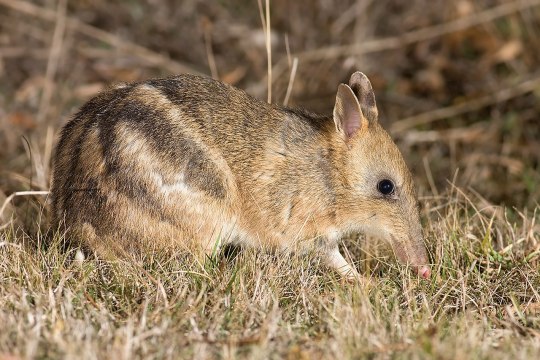

Peramelemorphia. This order is made up of bandicoots and bilbies; norcturnal omnivores and excellent diggers.
Dasyuromorphia. This order is made up of carnivorous marsupials, including quolls, numbats, and the Tasmanian devil.
#animals#biology#polls#poll tournament#zoology#bandicoots#bilbies#mammals#tetrapods#tasmanian devils#numbats#Peramelemorphia#Dasyuromorphia#0x10v0xef#Animal Tournament#Animal Tournament Round 1
32 notes
·
View notes
Text
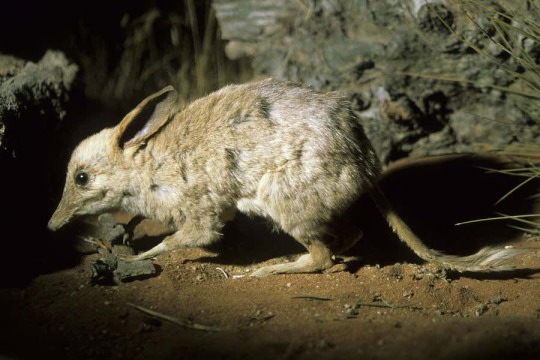
Chaeropus ecaudatus the Southern Pig–footed Bandicoot
Pig–footed bandicoots (genus Chaeropus) were so called because of their hooflike forefeet. They had relatively slender legs compared to other bandicoots, allowing them to move quickly through the landscape.
Although initially designated as a single species, Chaeropus yirratji was split from C. ecaudatus in 2019 on the basis of morphological differences. Both species became extinct by the 1950s due to habitat loss from land clearing for agriculture and predation from cats and foxes.
#southern pig–footed bandicoot#animals#australian animals#mammals#australian mammals#marsupials#australian marsupials#bandicoots#pig–footed bandicoot#s o: australidelphia#o: peramelemorphia#f: chaeropidae#g: chaeropus#sp: c. ecaudatus
32 notes
·
View notes
Text
i don't hate animals.
"The Rumours going around say I hate animals.. that's not true. I just tend not like most from the Peramelemorphia order...most the animal kingdom don't seem like me."
"I always love my biology and study hard on fauna of the world, I do think many way more superior then to human race, our species can be very xenophobic made me less impressed with humans and certain parts my family way they treated me.. its why I started create new race anthro animals make my army."
" I had so many pets over years, I tend to them and I loved them... maybe to much love in few of me test experiments in evil academy."
"I know I'm no saint comes to ethical animal treatment. I am a evil scientist? I had use some human subjects testing for awhile but never gave best result. so kept them in the castle dungeons away from the world...but they did result help creating my helpful android lab assistants over years with the human tests."
"but I'm digressing.. back to animals, I do have my fav few I love, animals of greater intellect like parrots! Victor and Morris were my most beloved pets, yes its unfortunate what happen.. we all know TwinSanty fiasco.. don't remind me of the humiliation."
"hmmm I do like marine life, might have been a marine biologist if I wasn't put into madam Amberly academy. I do think dolphins and orcas are neat... *cough*why I have a dolphin tattoo *cough*. "
"even over few years my army had dispersed from failed attempts world domination. it resulted least they made own towns around the islands made bit more civilized and good neatwork of own economy. now i can go shopping again locally without have travel all way to continent and have a swat team trying arrest me, so could say I'm the creator of all this.. my credit making them get towns created on islands, i should have a statue of me in town square.. ungrateful lot."
"anyway... tiny maybe exception from all of it, he been loyal ever since I revived his fossil and evolved him and still is, his a good boy, so maybe Tasmanian tigers too on my list."
---
((headcanon** ~ all years cortex been mistreated by inner family, school and fellow humans in science community, it grown spiteful most humans, why keeps company people more like him, ngin, brio and exception of tropy too, he never feels comfortble be around human city's much these days and spit having so many felonies in some countries he cant go to anymore.
value of his family is few to ones close to him and treated him with respect, Nina, older sister, his younger brother and his mother.
reason started make army of animals more of a comfort he wont be betrayed by using cortex vortex to be loyal to him... but years went by the cortex vortex effects do wear off and made lot of his anthro army become the native new citizens of wumpa archipelago which started there own small towns.
Much humanity failed Dr Cortex in his youth to accept him be part of rest the world. at least he has wumpa islands feel be part of its citizens in a way.))
4 notes
·
View notes
Text
bandicoot-pés-de-porco
O bandicoot-pés-de-porco(a) (Chaeropus ecaudatus) era um marsupial da família Chaeropodidae, encontrado nas regiões áridas do interior da Austrália. O último exemplar foi coletado em 1907 nas redondezas do Lago Eire, Austrália do Sul. Registros não confirmados foram feitos até a década de 1920 por moradores locais e aborígenes.
Chaeropus ecaudatus

Classificação científicaedit
Domínio: Eukaryota
Reino: Animalia
Filo: Chordata
Classe: Mammalia
Infraclasse: Marsupialia
Ordem: Peramelemorphia
Família: †Chaeropodidae
Gênero: †Chaeropus
Espécies: †C. ecaudatus
Segundo a taxonomia de McKenna e Bell (1997), a Chaeropodidae era considerada uma subfamília da Peramelidae. Análises moleculares (Westerman et al. 1999, 2001) não mantiveram este arranjo, e indicaram que o Chaeropus é o grupo-irmão de todos os outros Peramelemorphia, e portanto pertencia a uma família própria.
Nota (a): O termo "bandicoot" constitui um estrangeirismo, não possuindo termo equivalente em português, sendo assim o nome comum constitui um vernáculo artificial, pois deriva do nome popular em língua inglesa
Não há muitas informações sobre bandicoot-pés-de-porco
0 notes
Photo
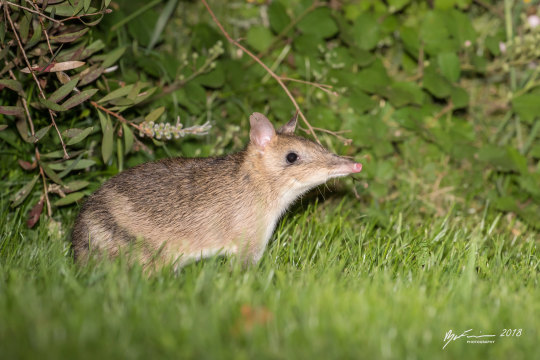
Eastern barred bandicoot (Perameles gunnii)
Photo by Ryan Francis
#eastern barred bandicoot#bandicoot#perameles gunnii#perameles#peramelinae#peramelidae#peramelemorphia#australidelphia#marsupialia#metatheria#mammalia#tetrapoda#vertebrata#chordata
115 notes
·
View notes
Text

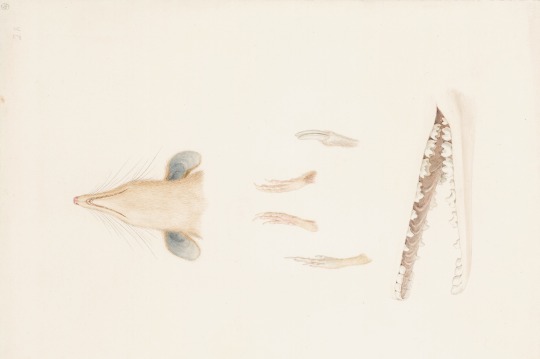
Western Barred Bandicoot, Perameles bougainville (1801) - Ferdinand Bauer
#Wonder Rooms#Cabinet of Curiosities#Public Domain#19th Century#Natural History#Scientific Illustration#Ferdinand Bauer#Zoology#Animalia#Mammalia#Marsupialia#Peramelemorphia#Peramelidae#Perameles
8 notes
·
View notes
Text
†Pig-footed Bandicoots (Chaeropus)
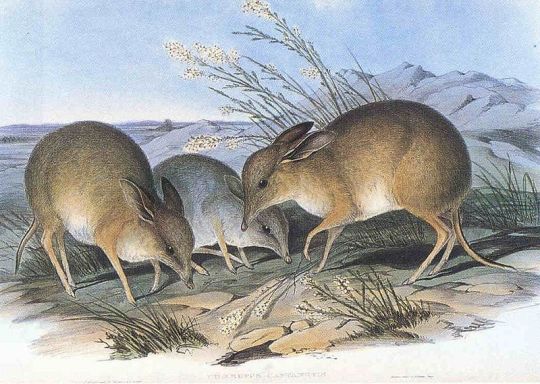
Pig-footed bandicoots were recently considered separate to all other bandicoots. Two similar species are recognized, varying in historical ranges and morphology of dentition and feet. Their fur ranged from uniform grey-brown to russet and fawn tones, helping them camouflage into arid sandy desert and grassland. From 32 to 40cms long, they measured up similarly to a small rabbit.
Chaeropus, uniquely, had feet like tiny hooves. They walked on only two functional toes of the forefeet, and one toe of the hind-foot, the rest being vestigial. They were known to run very fast, with a quick bounding gait. Though reported to eat insects, it’s thought they were largely herbivorous.
The Southern pig-footed bandicoot, C. ecaudatus, occurred through desert shrub-lands in the lower part of South Australia extending into Western Australia. C. yirratji, the Northern pig-footed bandicoot, inhabited grassland and sandy desert in central Australia and WA.
Both species were never prolific according to Indigenous oral tradition. However, they were in serious decline by the 19th century and were extinct less than 150 years after European description. Foxes were not yet established in their ranges, and though some cats were, the cessation of thousands of years traditional burning practices is thought to have been the major contributor to their extinction. Burning provided a patchwork of new growth on which to feed alongside recovered zones of shelter. Introduction of sheep and cattle also changed the landscape dramatically, further decimating crucial food sources of native animals.
#Chaeropus#pig-footed bandicoot#Chaeropodidae#Southern pig-footed bandicoot#Northern pig-footed bandicoot#Chaeropus ecaudatus#Chaeropus yirratji#Peramelemorphia#marsupials#australian animals#australian wildlife#Australidelphia#extinction
57 notes
·
View notes
Photo
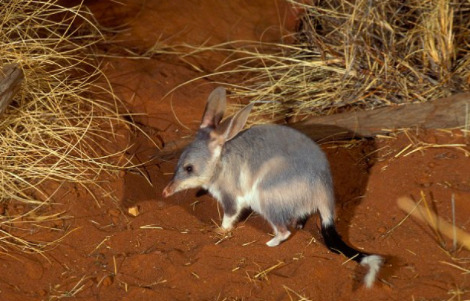
1 note
·
View note
Photo
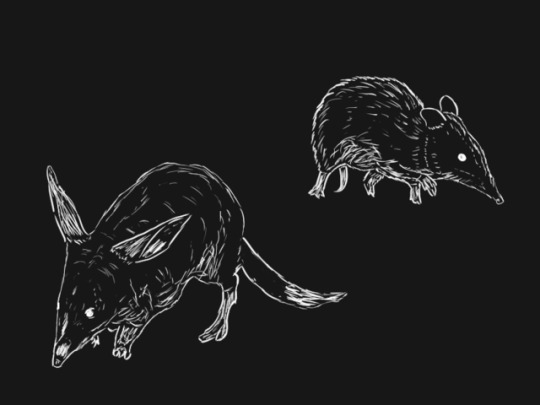
SSS 40 (Peramelemorphia)
So I felt like experimenting with reverse gradients (unlike what I did for the New Years piece) and figured "Why not draw something nocturnal so the correction layer would like something taken from a night-vision camera?"
And that is how I decided to draw a Greater Bilby (left) and Long-Nosed Bandicoot (right), so yeah...
#SouthSummerSketches#digital drawing#beginner artist#cute animals#mammal#marsupial#nocturnal#omnivore#peramelemorphia#bandicoot#macrotis#bilby
0 notes
Photo









Photos from the Healesville Sanctuary in Victoria. I loved this bushland refuge and was glad to escape the city for a day to see the Victorian countryside. They have an amazing program showcasing the parrots and birds of prey of Australia, including the wedge-tailed eagle!
1. One of my favorite mammals ever, the echidna (Tachyglossus).
2. A pic of the elusive platypus (Ornithorhynchus anatinus). This monotreme is in a constant state of motion, swimming and hunting. Capturing pictures was hard!
3. A denizen of the nocturnal exhibit, the brushtail possum (Trichosurus vulpecula).
4. Another very special marsupial, the greater bilby (Macrotis lagotis).
5. The skull of Thylacoleo, a rather derpy Pleistocene mammal known as the marsupial lion.
6. An Aboriginal rendition of the platypus. Fun fact: my dad was unfamiliar with the didgeridoo and thus made the comment “I don’t get why they’re playing this goofy music”...
7. All aboard this adorable echidna train! (I love echidnas ok don’t judge.)
8. I got more quality hangout time with my favorite marsupial, the Tasmanian devil (Sarcophilus harrisi). This one was named Joey! I also got to meet a little bab Tassie devil.
9. Joey’s keeper was near the enclosure so he was very hopeful for more food. Healesville Sanctuary and Zoos Victoria are doing important work building an insurance population in Australia as the Tasmanian wild population is being ravaged by a tumor disease that spreads like a virus, and it is always fatal. The official program of the Australian government can be found here.
#I love my tassie devils#devil facial tumor disease breaks my heart#Maru's adventures down unda#Healesville Sanctuary#Monotremata#Peramelemorphia#Dasyuromorphia#phalangeriformes#Maruchelys op#photo
1 note
·
View note
Text
The greater bilby, often referred to simply as the bilby since the lesser bilby became extinct in the 1950s, is an Australian species of nocturnal omnivorous animal in the order Peramelemorphia. Other vernacular names include dalgyte, pinkie, or rabbit-eared bandicoot. Greater bilbies live in arid parts of northwestern and central Australia.
I want to pet them
perthzoo
#bilby#bandicoot#rabbit-eared bandicoot#i had to look up the info#since i didn't know what they were#then i figured probably not everyone does#so I added the info
48 notes
·
View notes
Text

Bandicoots in the genus Isoodon: Golden Bandicoot I. auratus; Northern Brown Bandicoot I. macrourus; Southern Brown Bandicoot I. obesulus.
From Menkhorst and Knight (2001) 'A Field Guide to the Mammals of Australia'
#animals#australian animals#mammals#australian mammals#marsupials#australian marsupials#bandicoots#golden bandicoot#northern brown bandicoot#southern brown bandicoot#s o: australidelphia#o: peramelemorphia#f: peramelidae#s f: peramelinae#g: isoodon#sp: i. auratus#sp: i. macrourus#sp: i. obesulus
1 note
·
View note
Photo
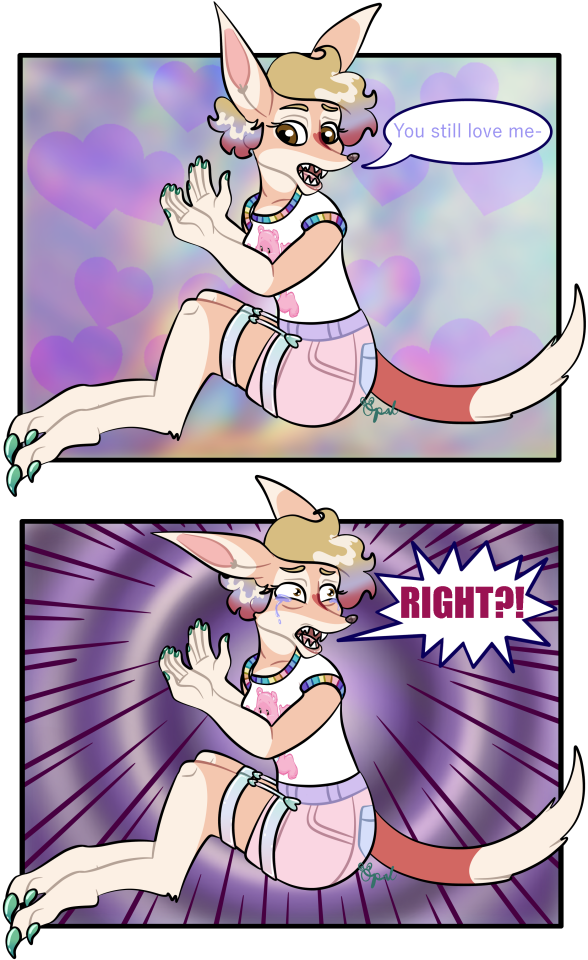
In which Opal is turned into a mutant bilby due to a freak experiment gone wrong. She initially appears to take the drastic change well, far better than her time wielding spouses. However, it suddenly hits that their disdain for bandicoots/the order Peramelemorphia is... immense, to say the least. A moment of panic ensues.
#i may do a part two to this but idk#ahhh it feels nice to FINALLY do art again!!#i'm v proud of myself!!#Self Insert#Selfship#self shipping#self ship#f/o#f/o community#self shipping community#self ship community#self insert content#self insert community#opal loves her dragon babies!#my art#s/i community
5 notes
·
View notes
Text
Bilby
Bilbies are the only extant member of Thylacomyidae in the order Peramelemorphia, though their taxonomy has changed over the years.
#FaunaFocus #Bilby #Bilbies
Bilbies are the only extant member of Thylacomyidae in the order Peramelemorphia, though their taxonomy has changed over the years.
Bilbies are the only extant member of Thylacomyidae in the order Peramelemorphia after yallaras, or lesser bilbies (Macrotis leucura) became extinct. The placement of bilbies within the Peramelemorphia order has changed in recent years. Vaughan (1978) and Groves and…

View On WordPress
2 notes
·
View notes
Text
Anthro-Animal Universe: Large Anthros
This post focuses on how many varieties of the large anthros there might be in Anthro-Animal Universe. The mole-mice are already covered in another post, so they won’t be covered here.
I grouped similar animals together. The possums and opossums are grouped together. The bilbies and bandicoots are grouped with the rabbits, hares, and pikas. The quolls, Tasmanian devils, numbats, and thylacines are grouped with the Carnivora - since they’re all dog-like and/or cat-like in design. The hyraxes and wombats are grouped with Rodentia, due to similarity in design.
All are generous estimations, since all are rounded up.
Carnivora Group (including quolls, Tasmanian devils, numbats, thylacines; excluding bears, red pandas, coatis, raccoons, kinkajous, olingos, wolverines, skunks, seals, walruses): about 400 dog breeds, about 100 cat breeds, about 250 other species [about 750 varieties overall]
Rodentia Group (including hyraxes, wombats; excluding mice, voles, rats, gerbils, hamsters, lemmings, dormice, porcupines, birch mice, jumping mice, jerboas, spiny rats, naked mole rats, blesmols, kangaroo rats, porcupines, flying squirrels, beavers): about 100 hyrax subspecies, about 10 wombat species, about 700 species/subspecies [about 810 varieties overall]
Lagomorpha/Peramelemorphia Group (excluding New Guinean spiny bandicoots): about twenty Peramelemorphia species, about 100 Lagomorpha species [about 120 varieties overall]
Didelphimorphia/Diprotodontia Group (excluding fat-tailed mouse opossums, water opossums, woolly opossums, mouse opossums, gracile opossums, Chacoan pygmy opossums, Patagonian opossums, slender opossums, short-tailed opossums, gliders, bettongs, potoroos, rat-kangaroos, brushtail possums, kangaroos, wallabies, wallaroos, pygmy possums, honey possums, feather-tailed possums, wombats, koalas): about 30 Phalangeridae species, about 20 Petauridae species, about 25 Pseudocheiridae species, about 25 Didelphimorphia species [about 100 varieties overall]
That’s about 1800 large anthro varieties overall. While reproduction between the four groups is impossible, all reproduction is possible within the group. As such, there are plenty of dog-cat hybrids. Fur colours also range from shades of brown, shades of grey, or vibrant colours. So the possibilities are endless.
Overpopulation isn’t as big of an issue in that universe, as the anthro-animals have great regard for the environment. Even what we might think of as “big cities” are still surround by plenty of flora, and green energy (along with crystal energy) is used in place of fossil fuels.
There are about twenty times as much mole-mice as there are large anthros. Sapient birds and bats are each about a hundred times as populous as the large anthros. Horses are about 75% as populous as large anthros. Monkeys are about 80% as populous as large anthros. Non-monkey primates are about five times as populous as large anthros. Large bears are about twice as populous as large anthros, while raccoon-bears are about four times as populous as large anthros. Kangaroos, wallabies, and wallaroos are about half as populous as large anthros.
2 notes
·
View notes
Conversation
Best animals in each mammalian order
Rodentia: Naked mole rats (they're eusocial and cold-blooded, that's hardcore)
Chiroptera: Mouse-tailed bats (they got a tail!)
Soricomorpha: Cuban Solenodon (it's venomous and that's cool as hell)
Primates: Mandrills and geladas (they're Awful Hairy Men with fangs, i love that)
Carnivora: Spotted hyena (i LOVE THEM and their weird necks and legs)
Cetartiodactyla: Wild boar (i just think they're neat)
Diprodontia: Cuscuses (their FACES)
Lagomorpha: Hares (they're Big Creepy Rabbits)
Didelphimorpha: all of them except for the genus Thylamys
Dasyuromorphia: Tasmanian devils (yeah)
Afrosoricida: lowland streaked tenrec
Eulipotyphla: It turns out cuban solenodons are in THIS order and not soricomorpha so im changing the soricomorpha one to the water shrew
Cingulata: how can it not be Glyptodon?
Peramelemorphia: Bandicoots. Crash is my friend.
Scandentia: every animal in this order looks the SAME
Perissodactyla: Tapir.
Macroscelidea: i'm honestly tired of these shrew-looking things at this point but the Take A Closer Look At That Snout boy gets a pass
Pilosa: silky anteaters, they look like bad taxidermy
Monotremata: Echidna, knuckles is my friend
Proboscidea: Rhynchotherium
3 notes
·
View notes